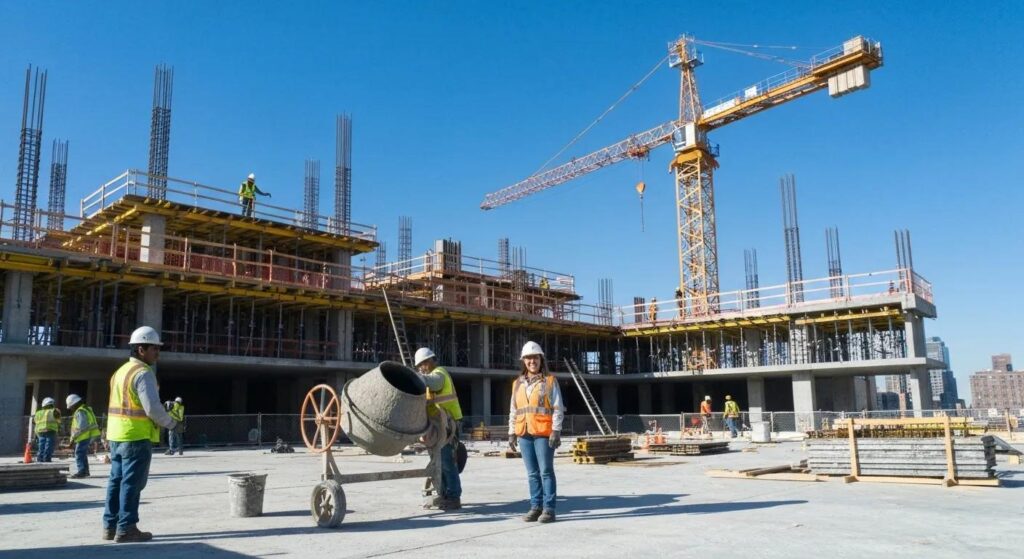
General Contractor vs. Design-Build: Which Is Best for Your Oklahoma City Construction Project?
Choosing the right project delivery method can make or break your Oklahoma City build, whether you’re planning a commercial renovation or a custom home addition. As a decision point between hiring a stand-alone general contractor or engaging an integrated design-build firm, this choice influences budget control, timeline efficiency, and quality outcomes. In this guide, you’ll discover exactly how each model works, compare key differences, evaluate local permit impacts, and learn how ACME Construction: Trusted Contractors in Oklahoma City can support your next project. You’ll explore:
- What a general contractor does and when to choose one
- How design-build streamlines delivery and fits complex builds
- Direct comparisons of communication, cost, schedule, and risk
- OKC-specific permitting requirements and local expertise
- ACME Construction’s capabilities in both models
- A clear decision framework for your budget, timeline, and involvement
With these insights, you’ll be ready to request a quote or call our team for a free consultation.
What Is a General Contractor and How Do They Manage OKC Construction Projects?
A general contractor is a licensed construction company responsible for executing building plans, coordinating trades, and securing permits for Oklahoma City projects. By managing subcontractors, scheduling inspections, and overseeing daily site operations, a general contractor ensures each construction phase aligns with architectural designs and client expectations. For example, a commercial tenant improvement in Midtown OKC relies on a GC to sequence drywall, masonry, and metal work efficiently while adhering to city inspections. Understanding this role sets the stage for comparing it with the design-build alternative.
What Are the Key Responsibilities of a General Contractor?
Key responsibilities of a general contractor include:
- Planning and sequencing all construction phases in compliance with OKC building codes
- Hiring and managing subcontractors for trades such as drywall, concrete, and masonry
- Securing and scheduling local permits and inspections with the City of Oklahoma City
- Monitoring site safety, quality control, and progress against the project schedule
- Handling cost-plus or lump-sum contracts, change orders, and budget tracking
These tasks deliver structured site management and clear accountability, which lead into how GCs interact with design professionals.
How Does a General Contractor Work with Architects and Designers?
A general contractor operates under a separate design contract, receiving completed plans before construction begins. Collaboration flows through:
- Design review meetings to clarify structural details and material selections
- Coordination sessions with architects for shop drawings and submittals
- Sequential handoffs between design completion and ground-breaking phases
This separation demands careful planning up front, preparing us to examine how design-build merges these stages for faster delivery.
When Should You Choose a General Contractor for Your OKC Project?
Consider the GC model when your project is:
- Smaller remodels or tenant improvements with fixed designs
- Highly specialized builds requiring competitive bidding for each trade
- Architect-led designs where you want direct design oversight
- Regulatory or historic renovations needing detailed code compliance
Selecting a general contractor in these scenarios offers clear scope boundaries while setting up the design-build discussion ahead.
What Is the Design-Build Model and How Does It Benefit Oklahoma City Projects?
Design-build is a delivery method where a single entity integrates architectural services and construction execution under one contract. By combining planning, engineering, and building teams, design-build reduces coordination gaps and accelerates start-to-finish timelines. For instance, a mixed-use complex in Bricktown OKC can shift rapidly from schematic design into site work without separate bid rounds, demonstrating the streamlined efficiency of a unified approach.
How Does Design-Build Streamline Project Delivery?
Design-build accelerates delivery through:
- One contract covering both design and construction milestones
- Overlapping design and construction phases to start early site work
- Centralized communication channels between architects, engineers, and builders
This integrated flow reduces wait times and information loss, which leads to tangible benefits for OKC clients.
What Are the Advantages of Design-Build for Commercial and Residential Projects in OKC?

Design-build provides OKC projects with:
- Fixed-price proposals that lock in budgets before extensive design fees
- Compressed schedules by overlapping design and construction activities
- Consistent quality through single-point accountability for design and build
- Simplified change management with unified teams responding rapidly
These advantages directly address local cost-per-square-foot pressures and tight project timelines in Oklahoma City.
When Is Design-Build the Best Choice for Your OKC Construction Project?
Design-build excels when projects feature:
- Complex site conditions or phased deliveries requiring flexible sequencing
- High stakes budgets where avoiding cost overruns is critical
- Developer-led builds needing rapid permit acquisition and start dates
- Clients preferring a single point of contact for all design and construction questions
Knowing these criteria helps you decide between the general contractor and design-build pathways.
What Are the Main Differences Between General Contracting and Design-Build?
Below is a detailed comparison of both models across key project attributes.
| Project Attribute | Traditional General Contractor | Design-Build Integration |
|---|---|---|
| Contract Structure | Separate design and construction bids | Single unified contract |
| Communication Flow | Client ↔ Architect ↔ GC | Client ↔ Design-Build team |
| Budget Control | cost-plus or lump-sum after design | Guaranteed maximum price early in design |
| Schedule Management | Sequential design then build | Phased and overlapping design/build phases |
| Risk Allocation | Client bears design-construction gaps | Design-build firm assumes coordination risk |
This side-by-side view underscores how each method allocates control, communication, cost, time, and risk differently before we explore each dimension in detail.
How Do Project Control and Communication Differ Between the Two Models?
Project control under a general contractor requires the client to coordinate between architect and builder, while design-build centralizes decision-making within one team. In practice:
- GC model involves three-way updates and separate approval cycles
- Design-build offers daily design-build stand-ups and faster approvals
- Single-point communication with design-build reduces errors and delays
These differences set the tone for budget and scheduling trade-offs.
What Are the Cost and Budget Implications of Each Method?
Budgeting in general contracting often uses cost-plus or lump-sum bids after full design, which can lead to variable estimates. In contrast, design-build firms deliver:
- Guaranteed maximum price (GMP) agreements during schematic design
- Early cost modeling to align with project objectives
- Consolidated billing that avoids separate architect and contractor fees
Understanding these approaches helps you match budget predictability to your risk tolerance.
Cost Savings in Design-Build Projects
Design-build projects can offer cost advantages through guaranteed maximum price agreements early in the design phase. This approach allows for early cost modeling and can help align with project objectives, potentially reducing the risk of cost overruns.
American Institute of Architects, “The Integrated Project Delivery Guide” (2017)
This citation supports the article’s discussion of the cost benefits associated with the design-build method.
How Do Timelines and Scheduling Compare in General Contracting vs. Design-Build?
Scheduling under the GC model follows distinct phases—design completion → bidding → construction start—whereas design-build leverages:
- Overlapping design and site preparation to reduce overall duration
- Fast-track procurement of long-lead items during early design
- Integrated milestone planning with design and construction teams
You’ll see up to 20% faster delivery on average when choosing design-build for complex OKC projects.
Design-Build Project Delivery Advantages
Design-build projects often lead to significant time savings compared to traditional methods. This is achieved through overlapping design and construction phases, which can accelerate project timelines and reduce overall project duration.
Construction Management Association of America, “Design-Build Project Delivery”
This research supports the article’s claims about the time-saving benefits of the design-build model.
What Are the Risks and Quality Considerations for Each Approach?
Traditional contracting risks include design-construction misalignment, change-order disputes, and budget overruns. Design-build risks revolve around reduced owner control over design tweaks. Quality considerations feature:
- GC: multiple quality checkpoints through architect and owner reviews
- Design-build: unified quality standards managed by the same team
- Both methods demand documentation, inspections, and client approvals
Evaluating risk profiles ensures you choose the method that aligns with your quality priorities.
How Do Local Oklahoma City Regulations and Permits Affect Your Choice Between General Contractor and Design-Build?
Oklahoma City projects must comply with municipal zoning, building code revisions, and permit registration for commercial contractors. Whether you hire a GC or design-build firm, your delivery method should factor in these local requirements to avoid delays and fines.
What Permits Are Required for Commercial and Residential Projects in OKC?
Major permits in Oklahoma City include:
- Commercial building permits for new construction or change of occupancy
- Residential permits for additions, garage conversions, and major remodels
- Trade permits (electrical, plumbing, HVAC) linked to subcontractor registrations
- Special inspections for structural, fire-rated, and accessibility compliance
Navigating this process efficiently depends on the depth of local permit experience.
How Does Local Expertise Impact Project Success in OKC?

Working with a provider who knows Oklahoma City codes ensures:
- Faster permit reviews and approvals through established relationships
- Accurate interpretation of zoning overlays and historic district rules
- Smoother inspections by local plan reviewers and building officials
- Access to trusted subcontractors familiar with city inspection protocols
Local expertise accelerates your schedule and stabilizes project costs in the OKC market.
How Can AcmeOK Support Your Project Using General Contracting or Design-Build in Oklahoma City?
ACME Construction serves as both a traditional general contractor and a flexible design-build partner for Oklahoma City businesses and homeowners. With in-house capabilities in concrete, drywall, masonry, and metal work, we adapt to your preferred delivery method while ensuring seamless coordination from concept through completion.
What Specialized Construction Services Does AcmeOK Provide in OKC?
ACME Construction delivers expertise in:
- Concrete foundations, slabs, and site paving
- Drywall installation, finishing, and acoustic assemblies
- Brick & stone masonry contractors for façades and retaining walls
- Structural metal framing, decking, and roof systems
These in-house trades minimize subcontractor handoffs and preserve quality.
How Does AcmeOK Manage Projects to Ensure Quality and Customer Satisfaction?
Our project management approach features:
- Detailed scheduling software with real-time progress tracking
- Weekly client meetings and transparent budget reporting
- Quality audits at each construction milestone
- Licensed, insured, and bonded teams committed to safety protocols
This disciplined process fosters trust and delivers predictable outcomes.
How Does AcmeOK Adapt to Both General Contracting and Design-Build Models?
ACME Construction tailors its services by:
- Integrating client-selected architects under a GC contract for design-bid-build projects
- Delivering full design-build packages with in-house designers and builders
- Offering collaborative value-engineering to optimize budget and timeline
- Maintaining consistency in quality whether under separate or unified contracts
Partner with ACME Construction: Trusted Contractors in Oklahoma City to leverage our local insight and comprehensive capabilities.
What Factors Should You Consider When Choosing Between a General Contractor and Design-Build for Your OKC Project?
Selecting the right delivery method depends on your budget goals, timeline constraints, and desired level of involvement. By evaluating these factors side by side, you’ll make an informed choice that aligns with your project vision.
How Do Budget, Timeline, and Project Complexity Influence Your Choice?
Weigh these decision criteria to match delivery method:
| Decision Factor | General Contractor Model | Design-Build Integration |
|---|---|---|
| Budget Predictability | Fixed bids after full design completion | Guaranteed maximum price early in schematic design |
| Schedule Control | Sequential design → build phases | Overlapping design and construction phases |
| Complexity Handling | Detailed design by separate architect | Integrated team addresses complexities continuously |
Understanding these trade-offs positions you to choose a method that fits your financial and scheduling priorities.
What Role Does Communication and Client Involvement Play in Selecting a Delivery Method?
Client engagement varies by model:
- GC: direct collaboration with architect, separate approvals, and routine site walkthroughs
- Design-build: one-stop communication hub with joint design-construction meetings
- Both models benefit from clear reporting, but design-build accelerates responsiveness
This insight guides your comfort level with day-to-day involvement.
How Can Risk Management Affect Your Project Delivery Decision?
Risk considerations drive method selection by:
- GC: owner assumes design-build coordination risk and change order disputes
- Design-build: firm absorbs coordination risk but may limit owner design control
- Mitigation tactics include detailed scopes, contingency budgets, and quality audits
Balancing risk allocation ensures your outcome meets quality, cost, and timeline expectations.
What Are Common Questions About General Contractor vs. Design-Build in Oklahoma City?
Clients often ask direct questions when planning their OKC construction projects. Below are concise answers to guide your decision.
What Is the Difference Between Design-Build and General Contractor?
Design-build merges design and construction under one contract, fostering real-time collaboration, budget certainty, and faster schedules. A general contractor model separates design and build phases, requiring multiple contracts but offering direct architectural oversight.
What Are the Pros and Cons of Design-Build?
Clients appreciate design-build for its single-point accountability, accelerated timelines, and upfront budget caps. Potential drawbacks include less owner control over fine-tuning design details once work begins.
When Should You Hire a General Contractor Instead of Design-Build?
Opt for a general contractor when you have a fully developed design, require competitive trade bidding, or need close involvement with an independent architect’s vision.
How Does Design-Build Save Money and Time?
By overlapping design and construction phases, eliminating separate bid processes, and locking in a maximum price early, design-build reduces overhead costs, change-order fees, and project duration.
How Do You Find Reliable Commercial General Contractors and Design-Build Firms in OKC?
To vet firms:
- Verify licenses, insurance, and bonding with the City of Oklahoma City
- Request case studies of similar OKC projects and client references
- Evaluate in-house trade capabilities for consistency and quality
- Confirm local permit experience and relationships with city inspectors
These steps help you select a partner who delivers on time, on budget, and to specification.
Delivering high-quality construction in Oklahoma City requires aligning your project’s scope, budget, and schedule with the right delivery method. Whether you choose a dedicated general contractor or an integrated design-build partner, ACME Construction stands ready to guide you through permits, planning, and build—ensuring your vision becomes reality. Call us today at (405) 931-1492 or request a quote online to discuss your OKC project and secure a free consultation.
